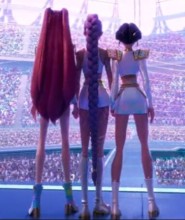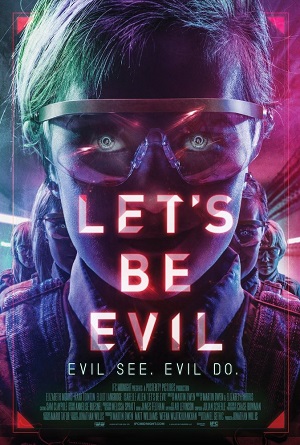
Initially Intriguing Let’s Be Evil a First-Person Waste of Time
Jenny (Elizabeth Morris) is ecstatic. She just got a job supervising gifted children in a top secret research facility, her new salary going to be more than enough to help her cover the medical bills accrued by her hopelessly ill mother. What she does not know is that this school is deep underground in a bunker, or that she’ll be sharing her duties with two others, Tiggs (Kara Tointon) and Darby (Elliot James Langridge), and absolutely no one else. More, the only way to see anything in the facility, let alone the children, is by wearing a special pair of Augmented Reality Glasses or ARGs, a virtual reality A.I. nicknamed ARIAL (voiced by Natasha Moore) the trio’s lone connection to the outside world.
It’s hard to know how much to say as it pertains to writer/director Martin Owen’s (L.A. Slasher) sophomore effort Let’s Be Evil. It’s safe to say, nothing is as it appears to be in this school, the children wandering the halls about as non-threatening as the blonde-haired urchins walking the streets of Midwich in Village of the Damned. These are scary kids, cut off from the world at large, living pretty much every second of their life online under the direction of a massive computer program completely devoid of any sort of human interaction. While they’re all geniuses, that doesn’t make them saints, their ability to differentiate between right and wrong not too shockingly underdeveloped.
All of which is fine, and I love the fact Owen, who crafted the initial story with his star Morris, they in turn inspired by an original scenario conceived by Jonathan Willis, drops the audience right into the middle of this first-person mystery box with almost nothing in the way of an initial explanation as to what is going on. Additionally, he sets the rules for the environment while also establishing the underground bunker’s geography, that way it’s relatively easy to keep track of where the characters are or where it is they are going for most of the film’s rapid-fire 83 minutes.
Problem is, for very smart people, a fact we are reminded of multiple times over, Jenny, Tigg and Darby make a lot of dumb decisions, and even though they’re all up against a gaggle of pint-sized geniuses they’re far too trusting of both the A.I. ARIAL as well as the kids themselves even after all the evidence shouts at them not to be. There is also little in the way of character development, and other than our primary heroine it’s exceedingly difficult to care about almost anyone here. The children, save one girl named Cassandra (Isabelle Allen), are faceless nobodies, and while I get the idea that this was to make them scarier, more unsettling, the exact opposite actually takes place, and for the most part they’re all ghostly phantoms with vague, nondescript powers than they are anything concretely fearsome.
It’s terrifically shot by Chase Bowman (Slow Learners), however, and anyone who has ever played spooky first-person horror games like Silent Hill or early versions of Resident Evil will certainly get swept up in these viscerally unsettling visual compositions. Melissa Spratt’s production design, as sparse and as relatively simple as it might appear to be, is also excellent, while composer Julian Scherle’s energetic score is simply out of this world. On a technical front, Owen gets just about everything right, the look and feel of the film consistently engaging even when the characters running around this maze trying their best to survive end up proving to be anything but.
And that’s the problem. While I get the feeling Morris could be a terrific young talent worth keeping an eye on, she’s practically the only reasons to care about anything that’s happening here. Even with Jenny, though, things are kept just vague enough to make her growing apprehension and fear not resonate, and why she continues to follow ARIAL’s instructions even after she learns the A.I.’s programming has been compromised simply a bridge too far. As for Darby and Tigg, they’re just not worth emotionally investing in, caring what happens to either of them close to impossible.
The point of it all, which I can only surmise pertains to humanity’s relationship with technology and how it is erasing items like empathy and compassion from the public psyche, especially as it concerns children, is delivered with heavy-handed didacticism, only getting worse as events progress. Towards the end, Owen begins to subvert his own established rules, gifting his tiny terrors extra powers that are so random it’s almost as if he and his team made them up as shooting on the film progressed. It all builds to an unsatisfying conclusion that is neither scary nor shocking, only perfunctorily anticipated, frustrating me to no end because the potential for something far more interesting and disquieting was there.
It all looks and sounds fantastic, and I do feel like the early portions setting up this world and Jenny’s place inside of it are intriguing. But the film never delivers on that promise, doesn’t go further than it needs to in order to lay down the most basic of foundations. The final scenes are utter nonsense engineered to register a traumatized “Twilight Zone” style reaction but instead are so absurd they’re just plain silly, ultimately making Let’s Be Evil nothing more than cinematic sound and fury signifying little substantive and even less that’s memorable.
Film Rating: 2 (out of 4)








